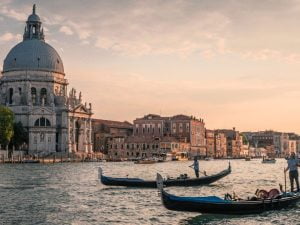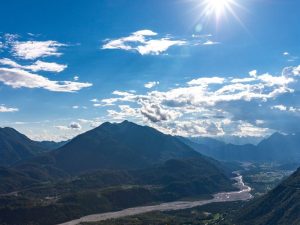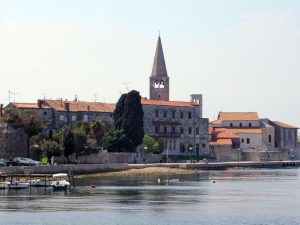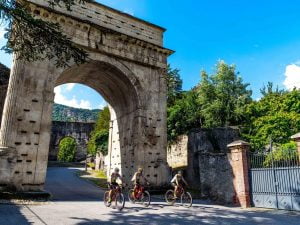The pleasure of cycling on the Alpe Adria cycling path from the city of Mozart to the Adriatic Sea
In a week across the Alps to the Adriatic Sea – that sounds like hard work! It is not quite as exhausting, if you choose the Alpe Adria cycle route. On the well marked paths the crossing of the Alps is also feasible for pleasure cyclists, because the ascent to the main ridge of the Alps is divided into two daily stages, the last one iwill be done by using the train. On your journey you will cross the idyllic Salzach valley, Bad Gastein, the impressive high mountain landscape of the Hohe Tauern, the sunny Trautal and the wildly rugged canal valley. Cycling on the Via Julia Augusta you pass Palmanova and Aquileia and get to the fishing village of Grado.
ITINERARY
Day 1: Arrival at Salzburg
Individual arrival at the starting hotel in Salzburg. A bicycle trip could not start more impressively than in Salzburg, the city of Mozart, a beautiful old town where are surrounded by many Baroque monuments. Take some delicious Mozartkugeln (typical Austrian confectionary) with you on your journey to the sea.
Day 2: Salzburg – Werfenweng (approx. 50 km)
With a view of the fortress Hohensalzburg you leave the city. In the distance the mountains are already visible. The first section takes you along the Salzach. On the way you will pass the former summer residence of the Salzburger Bishops, Hellbrunn palace. For more than 400 years, the extraordinary water games have been a delight for young and old. On the Tauern cycle path, the journey continues in the direction of Hallein, known for its crooked town-houses and above all for the white gold – salt. Passing below the Tennengebirge mountains, you will cycle towards your destination Werfenweng, but first you will have to overcome a few metres in altitude. High above you will see the impressive 11th century castle of Hohenwerfen.
Day 3: Werfenweng – Bad Gastein (approx. 60 km)
The journey continues through the tranquil Gastein valley, only accessible along mountain paths and narrow roads until the 20th century. Framed by the peaks of the Hohe Tauern, you cycle along the Gasteiner Ache (river). Passing Dorfgastein and Bad Hofgastein you reach the famous health resort Bad Gastein. The „Montecarlo of the Alps“, as the place is often called, is known for its many splendid hotels from the „Belle Époque“. The main attraction here is the Gastein waterfall, which has been the focal point of many artists and poets. If you are there early enough, you can still take the cable car to the summit and enjoy the alpine panorama.
Day 4: Bad Gastein – Millstätter See (train + approx. 70 km)
In Böckstein you have to board the train, which takes you in about 11 minutes comfortably under the spectacular peaks of the Hohe Tauern into the Mölltal valley. Instead of following the original Alpe Adria cycle path, we sug- gest an alternative through the tranquil Dösental. On the old railway track, an 8 km long descent, leads down to the Glocknerradweg and along the Möll river. The varied landscape will not let you get bored. Today‘s destination is Millstatt, situated on the lake of the same name. At around 141 m the Millstätter See is the deepest lake in Carinthia.
Day 5: Millstätter See – Tarvis (approx. 78 km or 60 km + train, ticket not included)
On today ́s stage you cycle around the lake with its crystal-clear water for a while and then overcome a small ridge which brings you into the Drau Valley. After this detour, the Alpe-Adria route leads along the leisurely flowing Drava, where some surprises await you. Soon the direction of travel changes and you head south. First along the Gail river, which is ideal for cooling off on hot summer days, and then across the border to the „Bella Italia“. In the border triangle Austria-Slovenia-Italy lies the small town of Tarvis.
Day 6: Tarvis – Udine (approx. 120 km or approx. 80 km + train, ticket not included)
Although the fifth stage is one of the longest of this journey, there are very few ascents to overcome. Strengthened by cappuccino and brioche, you start the stage through the Kanal Valley, framed by the majestic peaks of the Julian Alps. On the disused railway line you cycle through a total of 22 tunnels. Don‘t miss the culinary delights along the way. Shortly before reaching Venzone, you cross the Tagliamento, one of the last natural rivers in Europe, before reaching the Friulian plain. Not only the vegetation changes, but also the temperatures continue to rise. Enjoy the evening at the „Piazza della Libertà“ in Udine, with its typical Italian atmosphere.
DAY 7: Udine – Grado (approx. 55 km)
Accompanied by the breeze of the Scirocco you pass through reed landscapes and water canals and arrive to Grado, a historic city of fishers and one of the most popular beach resorts on the Adriatic sea.
DAY 8: Departure
Individual departure or possibility to extend your stay on the Adriatic Sea.
Date & Price
Bike & Freedom
every Wednesday, Thursday, Friday and Saturday 27/04/2024 (first available date) to 22/09/2024 (last available date)
Other dates are possible upon request min. 5 persons
Season 1: from 27/04/2024 to 14/06/2024 (incl.) and from 09/09/2024 to 22/09/2024
Season 2: from 15/06/2024 to 08/09/2024 (incl.)
QUOTE
CAT A
€ 1.196,00 Package price per person in double room – Season 1
€ 1.299,00 Package price per person in double room – Season 2
€ 239,00 Surcharge single room
BIKE RENTAL
€ 119,00 Bike rental ( 21 gears)
€ 199,00 TOP Bike rental
€ 249,00 E-Bike rental
EXTRA NIGHT
IN SALZBURG
€ 109.00 Per person and night in a double room incl. breakfast
€ 69.00 Single room surcharge, per night
IN GRADO
€ 95.00 Per person and night in a double room incl. breakfast
€ 39.00 Single room surcharge, per night
PARKING
chargeable parking place either directly at the hotel or at public garage approx. 85.00 €/week.
TRANSFER
From Grado: on request return transfer from Grado to Salzburg by shuttle bus every Wednesday, Thursday,
Friday and Saturday, € 175.00 per person + € 39.00 per own bike, reservation and payment upon booking.
What’s included:
· 7 nights accomodation in guesthouses and hotels 3*** and 4****
· Breakfast
. Videobriefing
· Lugagge transfer
.Train ride Böckstein – Mallnitz bicycle included
· Road book and detailed info in English or German
. GPS data and APP available
· Help – desk
· Medical and luggage insurance
What is not included:
Travel to and from the place of departure, extras and everything not specifically listed in “What’s included”. Tourist tax, if due, is not included in the price and should be paide on site.
How to get there
By car: Salzburg is well connected to international motorways, and this makes the city easy to reach. If you reach the City of Mozart from Austria, take the A1 or A10 Motorway, or drive in from Germany on the A8.
By train: by offering numerous domestic as well as international connections, Salzburg Main Station is the most important rail hub in Western Austria. And since it lies right on the bor-
der with Germany, the station is administered jointly by Austrian Railways (ÖBB) and the Ger-
man Rail (DB). Timetables on: www.deutschebahn.de, www.oebb.at, www.trenitalia.com.
By plane: Salzburg W. A. Mozart Airport is the second-largest airport in Austria and is served by several different airlines. Furthermore, the major international airports in Vienna and Munich are only about 2 to 3 hours away with public transport
Map
eyJtYXBfb3B0aW9ucyI6eyJjZW50ZXJfbGF0IjoiNDYuNjcxMjkzOCIsImNlbnRlcl9sbmciOiIxMS4xNTI1MTc5Iiwiem9vbSI6NSwibWFwX3R5cGVfaWQiOiJST0FETUFQIiwiY2VudGVyX2J5X25lYXJlc3QiOmZhbHNlLCJmaXRfYm91bmRzIjpmYWxzZSwiY2VudGVyX2NpcmNsZV9maWxsY29sb3IiOiIjOENBRUYyIiwiY2VudGVyX2NpcmNsZV9zdHJva2Vjb2xvciI6IiM4Q0FFRjIiLCJzaG93X2NlbnRlcl9jaXJjbGUiOmZhbHNlLCJzaG93X2NlbnRlcl9tYXJrZXIiOmZhbHNlLCJjZW50ZXJfbWFya2VyX2ljb24iOiJodHRwOi8vd3d3LmJpY2lldmFjYW56ZS5pdC93cC1jb250ZW50L3BsdWdpbnMvd3AtZ29vZ2xlLW1hcC1nb2xkL2Fzc2V0cy9pbWFnZXMvL2RlZmF1bHRfbWFya2VyLnBuZyIsImRyYWdnYWJsZSI6dHJ1ZSwic2Nyb2xsX3doZWVsIjoiZmFsc2UiLCJnZXN0dXJlIjoiYXV0byIsIm1hcmtlcl9kZWZhdWx0X2ljb24iOiJodHRwOi8vd3d3LmJpY2lldmFjYW56ZS5pdC93cC1jb250ZW50L3BsdWdpbnMvd3AtZ29vZ2xlLW1hcC1nb2xkL2Fzc2V0cy9pbWFnZXMvL2RlZmF1bHRfbWFya2VyLnBuZyIsImluZm93aW5kb3dfc2V0dGluZyI6IjxkaXYgY2xhc3M9XCJmYy1tYWluXCI+XG48ZGl2IGNsYXNzPVwiZmMtaXRlbS10aXRsZVwiPnttYXJrZXJfdGl0bGV9IDxzcGFuIGNsYXNzPVwiZmMtYmFkZ2UgaW5mb1wiPnttYXJrZXJfY2F0ZWdvcnl9PC9zcGFuPjwvZGl2PlxuPGRpdiBjbGFzcz1cImZjLWl0ZW0tZmVhdHVyZWRfaW1hZ2VcIj57bWFya2VyX2ltYWdlfSA8L2Rpdj5cbjxwPnttYXJrZXJfbWVzc2FnZX08L3A+XG48YWRkcmVzcz48Yj5BZGRyZXNzIDogPC9iPnttYXJrZXJfYWRkcmVzc308L2FkZHJlc3M+XG48L2Rpdj5cbiIsImluZm93aW5kb3dfZ2VvdGFnc19zZXR0aW5nIjoiPGRpdiBjbGFzcz1cImZjLW1haW5cIj48ZGl2IGNsYXNzPVwiZmMtaXRlbS10aXRsZVwiPntwb3N0X3RpdGxlfSA8c3BhbiBjbGFzcz1cImZjLWJhZGdlIGluZm9cIj57cG9zdF9jYXRlZ29yaWVzfTwvc3Bhbj48L2Rpdj4gPGRpdiBjbGFzcz1cImZjLWl0ZW0tZmVhdHVyZWRfaW1hZ2VcIj57cG9zdF9mZWF0dXJlZF9pbWFnZX0gPC9kaXY+e3Bvc3RfZXhjZXJwdH08YWRkcmVzcz48Yj5BZGRyZXNzIDogPC9iPnttYXJrZXJfYWRkcmVzc308L2FkZHJlc3M+PGEgdGFyZ2V0PVwiX2JsYW5rXCIgY2xhc3M9XCJmYy1idG4gZmMtYnRuLXNtYWxsIGZjLWJ0bi1yZWRcIiBocmVmPVwie3Bvc3RfbGlua31cIj5SZWFkIE1vcmUuLi48L2E+PC9kaXY+IiwiaW5mb3dpbmRvd19za2luIjp7Im5hbWUiOiJkZWZhdWx0IiwidHlwZSI6ImluZm93aW5kb3ciLCJzb3VyY2Vjb2RlIjoiPGRpdiBjbGFzcz1cImZjLW1haW5cIj48ZGl2IGNsYXNzPVwiZmMtaXRlbS10aXRsZVwiPnttYXJrZXJfdGl0bGV9IDxzcGFuIGNsYXNzPVwiZmMtYmFkZ2UgaW5mb1wiPnttYXJrZXJfY2F0ZWdvcnl9PC9zcGFuPjwvZGl2PiA8ZGl2IGNsYXNzPVwiZmMtaXRlbS1mZWF0dXJlZF9pbWFnZVwiPnttYXJrZXJfaW1hZ2V9IDwvZGl2PnttYXJrZXJfbWVzc2FnZX08YWRkcmVzcz48Yj5BZGRyZXNzIDogPC9iPnttYXJrZXJfYWRkcmVzc308L2FkZHJlc3M+PC9kaXY+In0sImluZm93aW5kb3dfcG9zdF9za2luIjp7Im5hbWUiOiJkZWZhdWx0IiwidHlwZSI6InBvc3QiLCJzb3VyY2Vjb2RlIjoiPGRpdiBjbGFzcz1cImZjLW1haW5cIj48ZGl2IGNsYXNzPVwiZmMtaXRlbS10aXRsZVwiPntwb3N0X3RpdGxlfSA8c3BhbiBjbGFzcz1cImZjLWJhZGdlIGluZm9cIj57cG9zdF9jYXRlZ29yaWVzfTwvc3Bhbj48L2Rpdj4gPGRpdiBjbGFzcz1cImZjLWl0ZW0tZmVhdHVyZWRfaW1hZ2VcIj57cG9zdF9mZWF0dXJlZF9pbWFnZX0gPC9kaXY+e3Bvc3RfZXhjZXJwdH08YWRkcmVzcz48Yj5BZGRyZXNzIDogPC9iPnttYXJrZXJfYWRkcmVzc308L2FkZHJlc3M+PGEgdGFyZ2V0PVwiX2JsYW5rXCIgY2xhc3M9XCJmYy1idG4gZmMtYnRuLXNtYWxsIGZjLWJ0bi1yZWRcIiBocmVmPVwie3Bvc3RfbGlua31cIj5SZWFkIE1vcmUuLi48L2E+PC9kaXY+In0sImluZm93aW5kb3dfZHJvcF9hbmltYXRpb24iOmZhbHNlLCJjbG9zZV9pbmZvd2luZG93X29uX21hcF9jbGljayI6ZmFsc2UsImRlZmF1bHRfaW5mb3dpbmRvd19vcGVuIjpmYWxzZSwiaW5mb3dpbmRvd19vcGVuX2V2ZW50IjoiY2xpY2siLCJsaXN0aW5nX2luZm93aW5kb3dfb3Blbl9ldmVudCI6ImNsaWNrIiwiaXNfbW9iaWxlIjpmYWxzZSwiaW5mb3dpbmRvd19maWx0ZXJfb25seSI6ZmFsc2UsImluZm93aW5kb3dfY2xpY2tfY2hhbmdlX3pvb20iOjAsImluZm93aW5kb3dfY2xpY2tfY2hhbmdlX2NlbnRlciI6ZmFsc2UsImZ1bGxfc2NyZWVuX2NvbnRyb2wiOnRydWUsInNlYXJjaF9jb250cm9sIjp0cnVlLCJ6b29tX2NvbnRyb2wiOnRydWUsIm1hcF90eXBlX2NvbnRyb2wiOnRydWUsInN0cmVldF92aWV3X2NvbnRyb2wiOnRydWUsImxvY2F0ZW1lX2NvbnRyb2wiOmZhbHNlLCJtb2JpbGVfc3BlY2lmaWMiOmZhbHNlLCJ6b29tX21vYmlsZSI6NSwiZHJhZ2dhYmxlX21vYmlsZSI6dHJ1ZSwic2Nyb2xsX3doZWVsX21vYmlsZSI6dHJ1ZSwiZnVsbF9zY3JlZW5fY29udHJvbF9wb3NpdGlvbiI6IlRPUF9SSUdIVCIsInNlYXJjaF9jb250cm9sX3Bvc2l0aW9uIjoiVE9QX0xFRlQiLCJsb2NhdGVtZV9jb250cm9sX3Bvc2l0aW9uIjoiVE9QX0xFRlQiLCJ6b29tX2NvbnRyb2xfcG9zaXRpb24iOiJUT1BfTEVGVCIsIm1hcF90eXBlX2NvbnRyb2xfcG9zaXRpb24iOiJUT1BfUklHSFQiLCJtYXBfdHlwZV9jb250cm9sX3N0eWxlIjoiSE9SSVpPTlRBTF9CQVIiLCJzdHJlZXRfdmlld19jb250cm9sX3Bvc2l0aW9uIjoiVE9QX0xFRlQiLCJtYXBfY29udHJvbCI6ZmFsc2UsInNjcmVlbnMiOnsic21hcnRwaG9uZXMiOnsibWFwX3pvb21fbGV2ZWxfbW9iaWxlIjoiNSJ9LCJpcGFkcyI6eyJtYXBfem9vbV9sZXZlbF9tb2JpbGUiOiI1In0sImxhcmdlLXNjcmVlbnMiOnsibWFwX3pvb21fbGV2ZWxfbW9iaWxlIjoiNSJ9fSwibWFwX2luZm93aW5kb3dfY3VzdG9taXNhdGlvbnMiOmZhbHNlLCJpbmZvd2luZG93X3dpZHRoIjoiMTAwJSIsImluZm93aW5kb3dfYm9yZGVyX2NvbG9yIjoicmdiYSgwLCAwLCAwLCAwLjA5ODAzOTIpIiwiaW5mb3dpbmRvd19iZ19jb2xvciI6IiNmZmYiLCJzaG93X2luZm93aW5kb3dfaGVhZGVyIjpmYWxzZSwibWluX3pvb20iOiI3IiwibWF4X3pvb20iOiIxOSIsInpvb21fbGV2ZWxfYWZ0ZXJfc2VhcmNoIjoiMTAiLCJ1cmxfZmlsdGVycyI6ZmFsc2UsImRvdWJsZWNsaWNrem9vbSI6ZmFsc2UsImN1cnJlbnRfcG9zdF9vbmx5IjpmYWxzZSwiYm91bmRfbWFwX2FmdGVyX2ZpbHRlciI6ZmFsc2UsImRpc3BsYXlfcmVzZXRfYnV0dG9uIjpmYWxzZSwibWFwX3Jlc2V0X2J1dHRvbl90ZXh0IjoiUmVzZXQiLCJoZWlnaHQiOiI0MDAifSwicGxhY2VzIjpbeyJpZCI6IjY2MyIsInRpdGxlIjoiR2FyZGEyIiwiYWRkcmVzcyI6Ik1lcmFubywgU291dGggVHlyb2wsIEl0YWx5Iiwic291cmNlIjoibWFudWFsIiwibG9jYXRpb24iOnsiaWNvbiI6Imh0dHA6Ly93d3cuYmljaWV2YWNhbnplLml0L3dwLWNvbnRlbnQvcGx1Z2lucy93cC1nb29nbGUtbWFwLWdvbGQvYXNzZXRzL2ltYWdlcy8vZGVmYXVsdF9tYXJrZXIucG5nIiwibGF0IjoiNDYuNjcxMjkzOCIsImxuZyI6IjExLjE1MjUxNzkiLCJjaXR5IjoiVGlyb2wiLCJzdGF0ZSI6IlRyZW50aW5vLVNvdXRoIFR5cm9sIiwiY291bnRyeSI6Ikl0YWx5Iiwib25jbGlja19hY3Rpb24iOiJtYXJrZXIiLCJvcGVuX25ld190YWIiOiJ5ZXMiLCJkcmFnZ2FibGUiOmZhbHNlLCJpbmZvd2luZG93X2RlZmF1bHRfb3BlbiI6ZmFsc2UsImluZm93aW5kb3dfZGlzYWJsZSI6dHJ1ZSwiem9vbSI6NSwiZXh0cmFfZmllbGRzIjp7Imxpc3RvcmRlciI6MH19fSx7ImlkIjoiNjY0IiwidGl0bGUiOiJHQVJEQSAyIiwiYWRkcmVzcyI6IkJvbHphbm8sIEl0YWx5Iiwic291cmNlIjoibWFudWFsIiwibG9jYXRpb24iOnsiaWNvbiI6Imh0dHA6Ly93d3cuYmljaWV2YWNhbnplLml0L3dwLWNvbnRlbnQvcGx1Z2lucy93cC1nb29nbGUtbWFwLWdvbGQvYXNzZXRzL2ltYWdlcy8vZGVmYXVsdF9tYXJrZXIucG5nIiwibGF0IjoiNDYuNDk0OTQ1IiwibG5nIjoiMTEuMzQwMjY1NyIsInN0YXRlIjoiVHJlbnRpbm8tU291dGggVHlyb2wiLCJjb3VudHJ5IjoiSXRhbHkiLCJvbmNsaWNrX2FjdGlvbiI6Im1hcmtlciIsIm9wZW5fbmV3X3RhYiI6InllcyIsImRyYWdnYWJsZSI6ZmFsc2UsImluZm93aW5kb3dfZGVmYXVsdF9vcGVuIjpmYWxzZSwiaW5mb3dpbmRvd19kaXNhYmxlIjp0cnVlLCJ6b29tIjo1LCJleHRyYV9maWVsZHMiOnsibGlzdG9yZGVyIjowfX19LHsiaWQiOiI2NjUiLCJ0aXRsZSI6IkdBUkRBMiIsImFkZHJlc3MiOiJBdWVyLCBTb3V0aCBUeXJvbCwgSXRhbHkiLCJzb3VyY2UiOiJtYW51YWwiLCJsb2NhdGlvbiI6eyJpY29uIjoiaHR0cDovL3d3dy5iaWNpZXZhY2FuemUuaXQvd3AtY29udGVudC9wbHVnaW5zL3dwLWdvb2dsZS1tYXAtZ29sZC9hc3NldHMvaW1hZ2VzLy9kZWZhdWx0X21hcmtlci5wbmciLCJsYXQiOiI0Ni4zNDgxNzk5IiwibG5nIjoiMTEuMjk5MDM1NCIsImNpdHkiOiJPcmEiLCJzdGF0ZSI6IlRyZW50aW5vLUFsdG8gQWRpZ2UiLCJjb3VudHJ5IjoiSXRhbHkiLCJvbmNsaWNrX2FjdGlvbiI6Im1hcmtlciIsIm9wZW5fbmV3X3RhYiI6InllcyIsInBvc3RhbF9jb2RlIjoiMzkwNDAiLCJkcmFnZ2FibGUiOmZhbHNlLCJpbmZvd2luZG93X2RlZmF1bHRfb3BlbiI6ZmFsc2UsImluZm93aW5kb3dfZGlzYWJsZSI6dHJ1ZSwiem9vbSI6NSwiZXh0cmFfZmllbGRzIjp7Imxpc3RvcmRlciI6MH19fSx7ImlkIjoiNjY2IiwidGl0bGUiOiJHQVJEQSAyIiwiYWRkcmVzcyI6IlRyZW50bywgVHJlbnRpbm8sIEl0YWx5Iiwic291cmNlIjoibWFudWFsIiwibG9jYXRpb24iOnsiaWNvbiI6Imh0dHA6Ly93d3cuYmljaWV2YWNhbnplLml0L3dwLWNvbnRlbnQvcGx1Z2lucy93cC1nb29nbGUtbWFwLWdvbGQvYXNzZXRzL2ltYWdlcy8vZGVmYXVsdF9tYXJrZXIucG5nIiwibGF0IjoiNDYuMDc0Nzc5MyIsImxuZyI6IjExLjEyMTc0ODYiLCJjaXR5IjoiVHJlbnRvIiwic3RhdGUiOiJUcmVudGluby1Tb3V0aCBUeXJvbCIsImNvdW50cnkiOiJJdGFseSIsIm9uY2xpY2tfYWN0aW9uIjoibWFya2VyIiwib3Blbl9uZXdfdGFiIjoieWVzIiwiZHJhZ2dhYmxlIjpmYWxzZSwiaW5mb3dpbmRvd19kZWZhdWx0X29wZW4iOmZhbHNlLCJpbmZvd2luZG93X2Rpc2FibGUiOnRydWUsInpvb20iOjUsImV4dHJhX2ZpZWxkcyI6eyJsaXN0b3JkZXIiOjB9fX0seyJpZCI6IjY2NyIsInRpdGxlIjoiR0FSREEyIiwiYWRkcmVzcyI6IlJvdmVyZXRvLCBUcmVudGlubywgSXRhbHkiLCJzb3VyY2UiOiJtYW51YWwiLCJsb2NhdGlvbiI6eyJpY29uIjoiaHR0cDovL3d3dy5iaWNpZXZhY2FuemUuaXQvd3AtY29udGVudC9wbHVnaW5zL3dwLWdvb2dsZS1tYXAtZ29sZC9hc3NldHMvaW1hZ2VzLy9kZWZhdWx0X21hcmtlci5wbmciLCJsYXQiOiI0NS44OTA5NiIsImxuZyI6IjExLjA0MDEzOTkiLCJjaXR5IjoiUm92ZXJldG8iLCJzdGF0ZSI6IlRyZW50aW5vLVNvdXRoIFR5cm9sIiwiY291bnRyeSI6Ikl0YWx5Iiwib25jbGlja19hY3Rpb24iOiJtYXJrZXIiLCJvcGVuX25ld190YWIiOiJ5ZXMiLCJwb3N0YWxfY29kZSI6IjM4MDY4IiwiZHJhZ2dhYmxlIjpmYWxzZSwiaW5mb3dpbmRvd19kZWZhdWx0X29wZW4iOmZhbHNlLCJpbmZvd2luZG93X2Rpc2FibGUiOnRydWUsInpvb20iOjUsImV4dHJhX2ZpZWxkcyI6eyJsaXN0b3JkZXIiOjB9fX0seyJpZCI6IjY2OCIsInRpdGxlIjoiR0FSREEyIiwiYWRkcmVzcyI6IlJpdmEgZGVsIEdhcmRhLCBUcmVudGlubywgSXRhbHkiLCJzb3VyY2UiOiJtYW51YWwiLCJsb2NhdGlvbiI6eyJpY29uIjoiaHR0cDovL3d3dy5iaWNpZXZhY2FuemUuaXQvd3AtY29udGVudC9wbHVnaW5zL3dwLWdvb2dsZS1tYXAtZ29sZC9hc3NldHMvaW1hZ2VzLy9kZWZhdWx0X21hcmtlci5wbmciLCJsYXQiOiI0NS44ODkxOTg0IiwibG5nIjoiMTAuODQzMDY5NiIsImNpdHkiOiJSaXZhIGRlbCBHYXJkYSIsInN0YXRlIjoiVHJlbnRpbm8tU291dGggVHlyb2wiLCJjb3VudHJ5IjoiSXRhbHkiLCJvbmNsaWNrX2FjdGlvbiI6Im1hcmtlciIsIm9wZW5fbmV3X3RhYiI6InllcyIsInBvc3RhbF9jb2RlIjoiMzgwNjYiLCJkcmFnZ2FibGUiOmZhbHNlLCJpbmZvd2luZG93X2RlZmF1bHRfb3BlbiI6ZmFsc2UsImluZm93aW5kb3dfZGlzYWJsZSI6dHJ1ZSwiem9vbSI6NSwiZXh0cmFfZmllbGRzIjp7Imxpc3RvcmRlciI6MH19fV0sIm1hcF9wcm9wZXJ0eSI6eyJtYXBfaWQiOiIxNTkiLCJkZWJ1Z19tb2RlIjpmYWxzZX0sInNoYXBlcyI6eyJkcmF3aW5nX2VkaXRhYmxlIjpmYWxzZSwic2hhcGUiOnsicG9seWxpbmVzIjpbeyJjb3JkaW5hdGVzIjpbIjQ2LjY3MDkxNjg3MjkxNTg5LDExLjE0MjkyNzc0NTQ4NjI4NiJdLCJzZXR0aW5ncyI6eyJzdHJva2VfY29sb3IiOiIjMDAzZGNlIiwic3Ryb2tlX29wYWNpdHkiOiIwLjUiLCJzdHJva2Vfd2VpZ2h0IjoiMSJ9fSx7ImNvcmRpbmF0ZXMiOlsiNDYuNjc0Njg2MDgyOTc3NzUsMTEuMTQ4NDIwOTA5NTQ4Nzg2IiwiNDYuNDg3Nzk0NTk1OTk5NTQ2LDExLjMzNTE4ODQ4NzY3Mzc4NiJdLCJzZXR0aW5ncyI6eyJzdHJva2VfY29sb3IiOiIjMDAzZGNlIiwic3Ryb2tlX29wYWNpdHkiOiIxIiwic3Ryb2tlX3dlaWdodCI6IjEifX0seyJjb3JkaW5hdGVzIjpbIjQ2LjQ4Nzc5NDU5NTk5OTU0NiwxMS4zMzc5MzUwNjk3MDUwMzYiLCI0Ni4zNDE5ODkwOTE0OTYyNSwxMS4yOTM5ODk3NTcyMDUwMzYiXSwic2V0dGluZ3MiOnsic3Ryb2tlX2NvbG9yIjoiIzAwM2RjZSIsInN0cm9rZV9vcGFjaXR5IjoiMC41Iiwic3Ryb2tlX3dlaWdodCI6IjEifX0seyJjb3JkaW5hdGVzIjpbIjQ2LjMzNDAyNDg1NzM5MDY1LDExLjI4NzE0NjE4NDcyMjU3IiwiNDYuMDY0MDc1MDA1NzQyNzgsMTEuMTIyMzUxMjYyODQ3NTciXSwic2V0dGluZ3MiOnsic3Ryb2tlX2NvbG9yIjoiIzAwM2RjZSIsInN0cm9rZV9vcGFjaXR5IjoiMSIsInN0cm9rZV93ZWlnaHQiOiIxIn19LHsiY29yZGluYXRlcyI6WyI0Ni4wNzAxNzI5ODQ3NDM5MzQsMTEuMTE4MjA4NTA3MjA1MDM2IiwiNDUuODgzMTE2NTg4OTI0MjMsMTEuMDMzMDY0NDY0MjM2Mjg2Il0sInNldHRpbmdzIjp7InN0cm9rZV9jb2xvciI6IiMwMDNkY2UiLCJzdHJva2Vfb3BhY2l0eSI6IjAuNSIsInN0cm9rZV93ZWlnaHQiOiIxIn19LHsiY29yZGluYXRlcyI6WyI0NS44NzczODA0MDQ3MDM1OTQsMTEuMDI3NTcxMzAwMTczNzg2IiwiNDUuODc5MjkyNTMxOTEwNzIsMTAuODM4MDU3MTQwMDE3NTM2Il0sInNldHRpbmdzIjp7InN0cm9rZV9jb2xvciI6IiMwMDNkY2UiLCJzdHJva2Vfb3BhY2l0eSI6IjAuNSIsInN0cm9rZV93ZWlnaHQiOiIxIn19XX19LCJmaWx0ZXJzIjp7ImZpbHRlcnNfY29udGFpbmVyIjoiW2RhdGEtY29udGFpbmVyPVwid3BnbXAtZmlsdGVycy1jb250YWluZXJcIl0ifX0=












